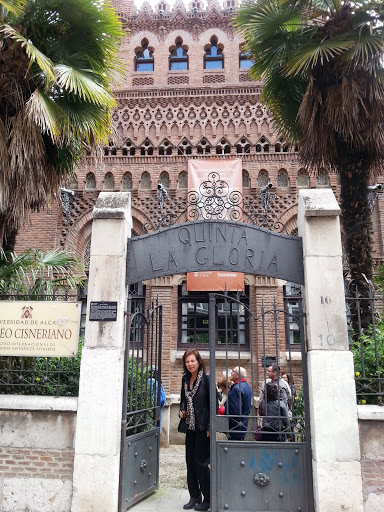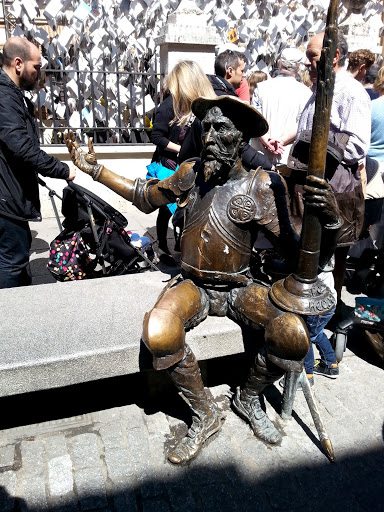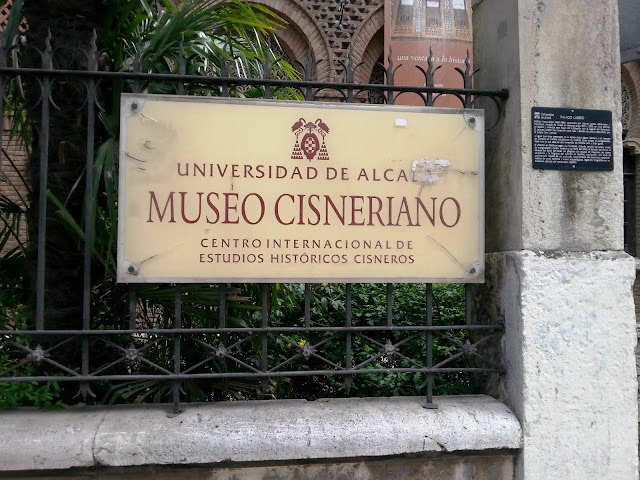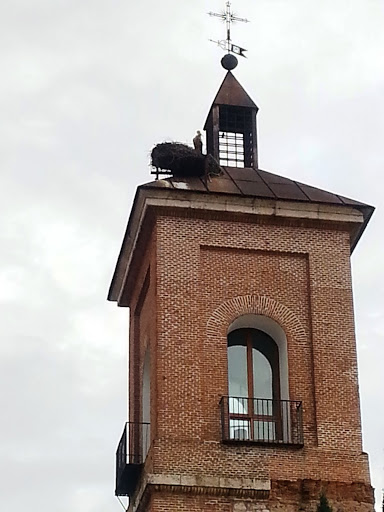Visiting Alcalá de Henares on the 400th anniversary of the death of Cervantes
When we boarded a train in Madrid for a day trip to Alcalá de Henares, I began thinking of the legendary figure Don Quixote lashing out at Castilla-La Mancha’s giant windmills with his faithful squire Sancho Panza in tow.

Situated about 22 miles northeast of the capital, Alcalá de Henares is the birthplace of Spain’s best known writer, Miguel de Cervantes. His famous novel, Don Quixote, is considered European literature’s first modern novel.
Like so many lovers of English and Spanish literature, I had to see what had inspired the renowned 16th century writer. So visiting the city UNESCO declared a World Heritage Site was high on my list. But little did I know we would be sharing our journey with hundreds of visitors who had the same idea.
It turns out that this is the 400th anniversary of the death of Cervantes, a contemporary of William Shakespeare. So we embarked on our 40-minute train ride to this Castilian city in the midst of a national celebration.

Each year on April 23, Alcalá hosts the king and queen of Spain as they present the Cervantes award in literature to an author from Spain and other Spanish-speaking countries. The day we visited, King Felipe VI, accompanied by Queen Letizia, had presented the prestigious award to a Mexican writer.
Unbeknownst to us, the highly publicized observance attracted hundreds of visitors. That’s why hordes of tourists spilled out of the train and onto the streets as soon as we arrived in the city the Romans called Complutum.
Since there were no signs posted indicating how to get to the birthplace of Cervantes, we stopped at a structure that looked like a palace to ask for directions. To our surprise, it was a palace known as Palacio Laredo.

The palace museum is dedicated to Cardinal Francisco Jimenez Cisneros. Among his many accomplishments, Cisneros decreed that a school founded by King Sancho IV in 1293 should be the University of Alcalá. Today, UA attracts students from around the globe who come to study Spanish.
Although the receptionist gave us good directions, we kept getting distracted by the ancient architecture. Consequently, we got lost several times before arriving at our destination. But we didn’t mind because we had already spent four cold, rainy weeks in Spain. So this lovely, sunny April day we were determined to keep walking until we reached “La Casa Natal de Cervantes” or Cervantes’ home.
This is a pedestrian friendly city that inspires visitors to walk its cobblestone streets. But from the train station to the bustling promenade on Calle Mayor- which ends in front of the Cervantes museum home-is a good half hour walk.

“All you have to do is follow the crowds because that’s where they are heading,” said one friendly shopkeeper. He was one of several people (we only asked those who looked like locals) who told us how to get where we were going.
He was so right. Everywhere we looked entire families, including moms pushing strollers, were walking in the same direction we were. We even spotted an elderly gentleman who traveled with us on the train. He had told us the University of Alcalá was as much a requisite site as the home of Cervantes.
Had we not walked, however, we would have missed the stunning town center. We stopped and shot photos of the towering statue of Miguel de Cervantes. The Plaza de Cervantes square is flanked by many trees still bare this late spring day.

Known as Al-Kala-en-Nahr during the Moorish occupation, this is a university town of 200,000 residents. It seemed wholly inconceivable that tourists would expect to see a taxi or city buses plying the streets of this fabled Castilian outpost.
Never having visited Alcalá, we didn’t know what to expect. But once we reached Calle Mayor, we knew instantly why it’s the city’s nerve center. There were old-time shops flanked by cafes and pubs everywhere.
The aroma of grilled meats, garlic, and other unidentifiable scents filled the air. The chatter and the laughter of people sitting outdoors was exciting to see as we strolled passed them in our quest to reach the museum at the end of the Calle Mayor.
We should have anticipated the long wait. As we stood in a long line for nearly two hours before entering the two-story house where Cervantes was born, we noticed iron statues of Don Quixote, the novel’s main character, and his trusty squire.
Camera-toting tourists snapped shot after shot of a seated Don Quixote with one out-stretched arm and a staff in the other. Sancho Panza sat right across from his master with his arms crossed. There were plenty of selfies taken as we waited.


We were surprised to learn admission was free. Once inside, we saw a typical Castilian courtyard with the original well from which the family took their water. The courtyard was surrounded by a kitchen, dining room, and a bedroom in which the women sewed and read.
One ground-floor room was dedicated to Rodrigo de Cervantes. The famed author’s father was a surgeon and barber. The room is called the “botica” or pharmacy because this room houses instruments he used in his profession.
Upstairs we entered a room with life-like puppets used to illustrate the love Cervantes had for writing theatrical plays. The room where the author once slept was filled with 17th century furniture and furnishings from the period in which Cervantes lived.

When we finished touring, we headed back toward the main square in search of the university. When we arrived, the line to get in was even longer than the line to get into the home of Cervantes.
After a few minutes, we were told we would not be allowed in until the next day. Having planned on returning to Madrid by train that evening, we begrudgingly relinquished our place in line.
Although 2 pm is not the usual lunch time in the United States, in Spain it’s the perfect time. In fact, from 2 to 4 pm many places still close for lunch. So we scoped out some hot spots until we found one that served genuine Castilian food.
Chickpea stew, roasted meats, and garlic soup are typical dishes from the region of Castile-La Mancha. But we included tapas, such as shrimp scampi and tortilla (potato omelet) in our dining experience.
The 400th anniversary of the death of Cervantes was a huge draw, but the city holds a popular classical theatre festival in June and July. Additionally, each October, Alcalá de Henares celebrates the birth of Cervantes (Oct. 9, 1547) with a colorful festival.

After time spent walking around the city we saw the 13thcentury Palacio Arzobispal or Archbishop’s Palace, and El Corral de Comedias or Comedy Corral, a theater founded in 1601 and still active today. We also stumbled upon the Cathedral of St. Justus and St. Pastor. But a huge bird’s nest, occupied by three white storks atop a historic building, literally stopped us in our tracks.
“Those nests are harmless and the residents are accustomed to having them on top of buildings in this town. But some of the nests can weigh as much as a ton,” said a man on a smoke break outside his business. He seemed amused, watching my husband snap picture after picture of the giant bird nests.

Right about that time, the birds left the nest with a sense of urgency. As we thanked the man for his input, the sky darkened and a downpour prompted us to seek shelter at a nearby church. Alcalá de Henares is filled with ancient historic churches and convents.
Many have been converted into educational facilities that house a law school, dormitories and other departments of higher education. So even though we didn’t see all the monuments and museums on this visit, we saw enough to know we will return to continue to explore this historic gem.
For more information, contact The Tourist Office of Spain at www.touristofspain.com or visit http://www.alcaladehenares.org.
For the Cervantes Museum, visit www.museocasanataldecervantes.org
Information on the Corral de Comedias is at www.corraldealcala.com
Rosie Carbo is the Lifestyles Editor for Wandering Educators, and is a former newspaper reporter whose work has appeared in newspapers and magazines nationwide. Some of those publications include People magazine, The Dallas Morning News, The Houston Chronicle and San Antonio Express-News. Some of her features were redistributed by The Associated Press early in her career as an award-winning Texas journalist.
All photos courtesy and copyright Rosie Carbo



















